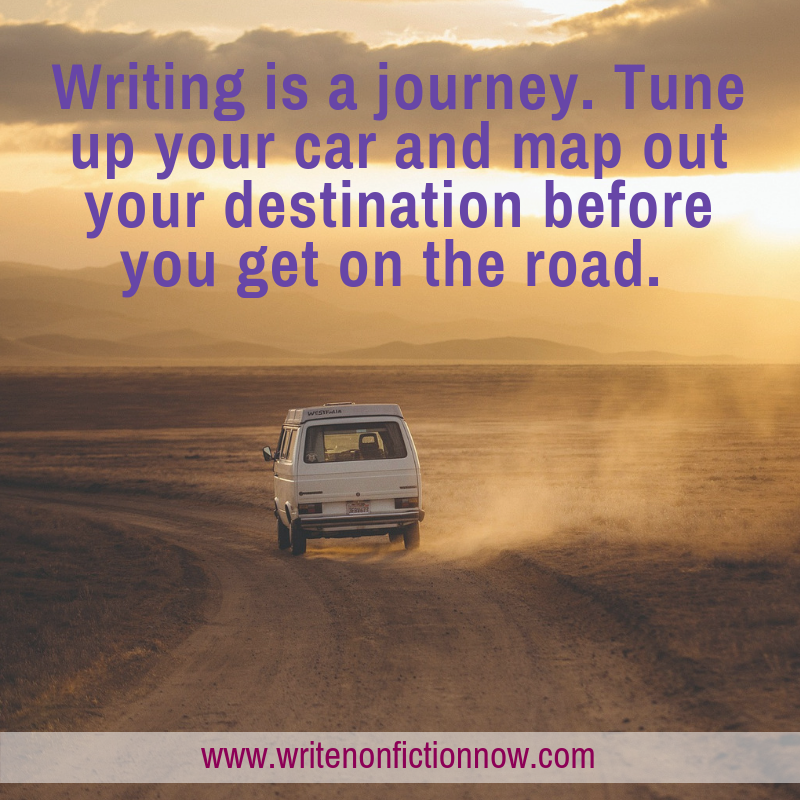On a recent road trip, I whiled away many hours writing from my perspective in the passenger’s seat. One might imagine that I would have a lot to show for the amount of time I spent writing as we drove those many miles. But, to be perfectly honest, I have nothing. No handwritten notes. No typed pages on my laptop. No touchscreen entries on my mobile phone.
The pieces I composed with gripping opening lines, engaging paragraphs, and alluring scenes, all took place in my head, and only in my head. Now, as I try to nurture them back to life, I can’t stop thinking about road trip metaphors and automobile maintenance…writing as a journey and writer like a car.
I started thinking you could just jump behind the wheel and take off for a long road trip without checking the parts of your vehicle. But, if you did, how long could you keep going? Is it worth taking the risk? And what if you didn’t map out your destination? Would you get off track and arrive late…or not at all?
In this article, we’ll take a look at areas writers must regularly inspect to keep the “motor” running smoothly, stay on track, and enjoy the trip.
#1: Keep the motor running.
Writers’ benefit from keeping their creative energies flowing. You could think of it like tuning up your engine so the motor runs smoothly. For me, I need a place where I can think, experience solitude and long uninterrupted periods of quiet.
Thanks to Virginia Woolf’s inspiration, I’ve given myself permission to carve out a room of my own. Many of us most likely won’t have the luxury of rooms of our own, but we can seek out the types of environments where our writing is more apt to thrive, e.g., a table at the library or comfy chair at a café. Perhaps we need the solace of ear-buds to block out distracting conversations and background music. Or maybe we find ourselves desperately eavesdropping for a spark of creativity.
Whatever it takes to find space—make it your own.
#2: Switch-up writing vehicles.
Prepare for writing time by scoping out tools that work for you. If you’re a keyboard kind of writer, question whether you should try writing with pen and paper. Try different pens and pencils. Some of my favorites pens include Lamy Safari fountain, Sakura Pigma Micron, Faber Castell Pitt Artist, and Sakura Gelly Rolls. For pencils, I’m partial to the Palomino Blackwing 602 and Papermate Mirado Black Warrior. And always keep a good sharpener nearby—a good point works wonders. (Try the Faber-Castell Grip Trio.)
The feel of different kinds of paper also enhances writing times. My personal favorites include Moleskine and Stone Paper.
Be open too to shifting the vehicle that gets words on the page. Once, when all my usual routines wouldn’t work, I took a long walk and spoke into an audio app on my phone. Getting the words out and then transcribing them helped my writing flow.
#3: Make direction adjustments.
Writers aren’t guaranteed smooth rides. Bumps in the road can quickly put a writers journey in jeopardy. If we’re lucky, we get to enjoy a few good writing hours here and there, and, hopefully, end up with a manageable amount of revisions. Summoning mindfulness and acceptance (even when on a tight deadline) may change our direction for the best.
Author, Roy Peter Clark writes, “As is my habit with books, I write a fast rough draft—without revising or even fact-checking. I have to move forward, or I will linger over a chapter forever. So now I have drafts of 43 chapters—each about 2,000 words long (with about 100 or so writing books highlighted—not one per chapter as I had intended). The contract calls for 75,000 words, so I have already exceeded that mark. My problem? I think I may only be half-way through. This happened once before with The Glamour of Grammar—130,000-word manuscript (100 chapters) but with a contract for 60,000 words. ‘Just cut 50 chapters,’ said my editor. And, yes, we did.”
#4: Recognize your signals and look for resources to keep you on track.
What keeps you on track, illuminates your vision for a piece, or indicates when you’re going in a different direction from the one you planned? How do you alert others to your sudden stops and standstill? The more we’re able to assess where we are in our writing process, the more we can look for resources that may offer insights to jumpstart us and get us on the road again.
Recently I came across a video class on Skillshare taught by writer Roxanne Gay entitled, Creative Writing for Impact: Looking Inward & Outward in Personal Essays. During the 1 hour video, I heard many pieces of advice that were helpful to me. For instance, read to know what works in published works, look at essays, and identify the places where a writer is looking inward and outward. Gay also spends a lot of time talking about how to revise your work and shares a useful checklist. (She says she found it online some years ago and has used in her classes.) Be sure to take a look at it for some useful ways to revise your creative nonfiction prose.
What tips do you have for staying on track with your writing or keeping your writing engine primed? Let me know in a comment below.
About the Author
 Deb Hemley writes memoir, personal essay, short fiction, and articles about social media. She has published pieces in Biographile, Hippocampus Magazine, All That Matters, and Survivor’s Review. You can follow her on Twitter @dhemley.
Deb Hemley writes memoir, personal essay, short fiction, and articles about social media. She has published pieces in Biographile, Hippocampus Magazine, All That Matters, and Survivor’s Review. You can follow her on Twitter @dhemley.
Photo courtesy of David Iskander on Unsplash

Barbara Ann Chase says
Do not wait until you have gathered all your research. This gives you a sense of accomplishment
James says
HELP!!
I am not a writer but something made me search for the meaning and purpose of life.
I now know exactly what life is and why….
But I don’t know how to write it to make sense to those who do not…
There is no secret except the very first moment of self aware consciousness of “I think therefore I am”
Sigh
Please help this book must be finished this year